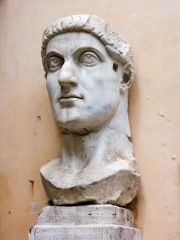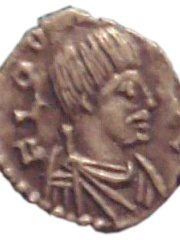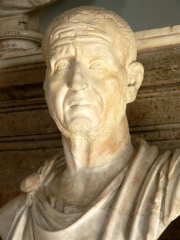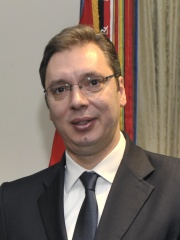







The Most Famous
POLITICIANS from Serbia
This page contains a list of the greatest Serbian Politicians. The pantheon dataset contains 19,576 Politicians, 105 of which were born in Serbia. This makes Serbia the birth place of the 38th most number of Politicians behind Brazil, and Canada.
Top 10
The following people are considered by Pantheon to be the top 10 most legendary Serbian Politicians of all time. This list of famous Serbian Politicians is sorted by HPI (Historical Popularity Index), a metric that aggregates information on a biography's online popularity. Visit the rankings page to view the entire list of Serbian Politicians.

1. Constantine the Great (272 - 337)
With an HPI of 89.00, Constantine the Great is the most famous Serbian Politician. His biography has been translated into 134 different languages on wikipedia.
Constantine I (27 February 272 – 22 May 337), also known as Constantine the Great, or known mononymously as Constantine, was Roman emperor from AD 306 to 337 and the first Roman emperor to convert to Christianity. He played a pivotal role in elevating the status of Christianity in Rome, the Edict of Milan decriminalising Christian practice and ceasing Christian persecution. This was a turning point in the Christianisation of the Roman Empire. He founded the city of Constantinople (now Istanbul) and made it the capital of the Empire, which it remained for over a millennium. Born in Naissus, a city located in the province of Moesia Superior (now Niš, Serbia), Constantine was the son of Flavius Constantius, a Roman army officer from Moesia Superior, who would become one of the four emperors of the Tetrarchy. His mother, Helena, was a woman of low birth, probably from Bithynia. Later canonised as a saint, she is credited for the conversion of her son in some traditions, though others believe that Constantine converted her. He served with distinction under emperors Diocletian and Galerius. He began his career by campaigning in the eastern provinces against the Persians, before being recalled to the west in AD 305 to fight with his father in the province of Britannia. After his father's death in 306, Constantine was proclaimed as augustus (emperor) by his army at Eboracum (York, England). He eventually emerged victorious in Civil wars of the Tetrarchy against the emperors Maxentius and Licinius to become the sole ruler of the Roman Empire by 324. Upon his accession, Constantine enacted many reforms to strengthen the empire. He restructured the government, separating civil and military authorities. To combat inflation, he introduced the solidus, a new gold coin that became the standard for Byzantine and European currencies for more than a thousand years. The Roman army was reorganised to consist of mobile units (comitatenses), often around the emperor, to serve on campaigns against external enemies or Roman rebels, and frontier-garrison troops (limitanei) which were capable of countering barbarian raids, but less and less capable of countering full-scale barbarian invasions. Constantine pursued campaigns against the tribes on the Roman frontiers—such as the Franks, the Alemanni, the Goths, and the Sarmatians—and resettled territories abandoned by his predecessors during the Crisis of the Third Century with citizens of Roman society. Although Constantine lived much of his life as a pagan, he later became a catechumen, as he began to favour Christianity in 312, finally being baptised by Eusebius of Nicomedia, an Arian bishop. He played an influential role in the proclamation of the Edict of Milan in 313, which legalized Christianity in the Roman Empire. He convoked the First Council of Nicaea in 325, which produced the Christian statement of belief known as the Nicene Creed. On his orders, the Church of the Holy Sepulchre was built at the site claimed to be the tomb of Jesus in Jerusalem and was deemed the holiest place in Christendom. He has historically been referred to as the "First Christian Emperor" but while he did favour the Christian Church, some modern scholars debate his beliefs and even his comprehension of Christianity. He is venerated as a saint in Eastern Christianity, and he did much to push Christianity towards the mainstream of Roman culture. The age of Constantine marked a distinct epoch in the history of the Roman Empire and a pivotal moment in the evolution from classical antiquity to the Middle Ages. He built a new imperial residence in the city of Byzantium, which was officially renamed New Rome, while also taking on the name Constantinople in his honour. It subsequently served as the capital of the empire for more than a thousand years—with the Eastern Roman Empire for most of that period commonly referred to retrospectively as the Byzantine Empire in English. In leaving the empire to his sons and other members of the Constantinian dynasty, Constantine's immediate political legacy was the replacement of Diocletian's Tetrarchy with the principle of dynastic succession. His memory was held in high regard during the lifetime of his children and for centuries after his reign. The medieval church held him up as a paragon of virtue, while secular rulers invoked him as a symbol of imperial legitimacy. The rediscovery of anti-Constantinian sources in the early Renaissance engendered more critical appraisals of his reign, with modern and contemporary scholarship often seeking to balance the extremes of earlier accounts.

2. Slobodan Milošević (1941 - 2006)
With an HPI of 81.78, Slobodan Milošević is the 2nd most famous Serbian Politician. His biography has been translated into 86 different languages.
Slobodan Milošević (Serbian Cyrillic: Слободан Милошевић, pronounced [slobǒdan milǒːʃevitɕ] , 20 August 1941 – 11 March 2006) was a Yugoslav and Serbian politician who was the President of Serbia between 1989 and 1997 and President of the Federal Republic of Yugoslavia from 1997 until his overthrow in 2000. Milošević played a major role in the Yugoslav Wars and became the first sitting head of state charged with war crimes. Born in Požarevac, he studied law at the University of Belgrade Faculty of Law during which he joined the League of Socialist Youth of Yugoslavia. From the 1960s, he was advisor to the mayor of Belgrade, and in the 1970s he was a chairman of large companies as the protégé of Serbian leader Ivan Stambolić. Milošević was a high-ranking member of the League of Communists of Serbia (SKS) during the 1980s; he came to power in 1987 after he ousted opponents, including Stambolić. He was elected president of the Socialist Republic of Serbia in 1989 and led the anti-bureaucratic revolution, reforming Serbia's constitution and transitioning the state into a multi-party system, reducing the power of autonomous provinces. He led the Socialist Party of Serbia from its foundation in 1990 until his death. Following the 1990 general elections, Milošević enacted dominant-party rule while his party retained control over economic resources of the state. During his presidency, anti-government and anti-war protests took place, and hundreds of thousands deserted the Milošević-controlled Yugoslav People's Army, leading to mass emigration from Serbia. During the NATO bombing of Yugoslavia in 1999, Milošević was charged for war crimes connected to the Bosnian War, Croatian War of Independence and Kosovo War by the International Criminal Tribunal for the former Yugoslavia (ICTY), a body of the United Nations. After resigning from the Yugoslav presidency in 2000 amidst demonstrations against the disputed presidential election, Milošević was arrested by Yugoslav federal authorities in March 2001 on suspicion of corruption, abuse of power, and embezzlement. The initial investigation faltered, and he was extradited to the ICTY to stand trial for war crimes. Milošević denounced the Tribunal as illegal and refused to appoint counsel, conducting his own defence. He died of a heart attack in his cell in The Hague in 2006 before the trial could conclude. The Tribunal denied responsibility for his death stating he had refused to take prescribed medicines for his cardiac ailments and medicated himself instead. After his death, the ICTY and International Residual Mechanism for Criminal Tribunals found he was a part of a joint criminal enterprise that used violence such as ethnic cleansing to remove Croats, Bosniaks and Albanians from parts of Croatia, Bosnia and Herzegovina, and Kosovo. The International Court of Justice (ICJ) concluded separately there was no evidence linking him to genocide committed by Bosnian Serb forces during the Bosnian War, but found Milošević had violated the Genocide Convention by failing to prevent genocide from occurring and to hold those involved accountable. Observers have described Milošević's political behavior as populist, eclectic, and opportunist. Milošević's rule has been described as authoritarian or autocratic, as well as kleptocratic, with accusations of electoral fraud, assassinations, suppression of press freedom, and police brutality.

3. Probus (232 - 282)
With an HPI of 80.76, Probus is the 3rd most famous Serbian Politician. His biography has been translated into 64 different languages.
Marcus Aurelius Probus (; 230–235 – September 282) was Roman emperor from 276 to 282. Probus was an active and successful general as well as a conscientious administrator, and in his reign of six years he secured prosperity for the inner provinces while withstanding repeated invasions of barbarian tribes on almost every sector of the frontier. After repelling the foreign enemies of the empire, Probus was forced to handle several internal revolts but demonstrated leniency and moderation to the vanquished wherever possible. Despite the military basis of his power, he presented himself as a constitutional monarch who respected the authority of the Roman Senate. Upon defeating the Germans, Probus re-erected the fortifications of emperor Hadrian between the Rhine and Danube rivers, protecting the Agri Decumates, and exacted from the vanquished a tribute of manpower to resettle depopulated provinces within the empire and provide for adequate defense of the frontiers. Despite his widespread popularity, Probus was killed in a mutiny of the soldiers while in the middle of preparations for the Persian war, which would be carried out under his successor Carus.

4. Odoacer (433 - 493)
With an HPI of 80.74, Odoacer is the 4th most famous Serbian Politician. His biography has been translated into 72 different languages.
Odoacer (c. 433 – 15 March 493 AD), also spelled Odovacer or Odovacar, was a barbarian soldier and statesman from the Middle Danube who was an officer of the Roman army and deposed the Western Roman child emperor Romulus Augustulus to become the ruler of Italy (476–493). Odoacer's overthrow of Romulus Augustulus is traditionally understood as marking the end of the Western Roman Empire. Although he ruled Italy, Odoacer styled himself a client of the Eastern emperor Zeno in Constantinople. He was addressed not only as rex but also as dux and patrician, the latter title granted by Zeno. In the sole surviving document from his chancery—and by the consul Basilius—Odoacer used the title of king. Backed by the Roman Senate, he distributed land with little resistance. Soldier unrest in 477–478 caused violence, but his later reign was stable. Though an Arian, he seldom interfered in the Trinitarian state church. Before becoming king, Odoacer led the revolt of Herulian, Rugian, and Scirian troops that deposed Romulus Augustulus on 4 September 476. The boy-emperor, elevated by his father Orestes less than a year earlier, never gained authority beyond central Italy. With senatorial support, Odoacer then ruled autonomously while formally recognizing both Julius Nepos and Zeno. After Nepos’s murder in 480, Odoacer invaded Dalmatia, executed the conspirators, and annexed the region within two years. In 484, when Illus, Eastern magister militum, sought his aid against Zeno, Odoacer invaded the emperor’s western provinces. Zeno retaliated by spurring the Rugii to attack Italy, but Odoacer crushed them north of the Danube in 487–488. To end the conflict, Zeno unleashed the Ostrogoth Theodoric the Great, who invaded in 489, seized most of Italy by 490, and forced Odoacer into Ravenna. After the city surrendered on 5 March 493, Theodoric invited him to a reconciliation banquet, where he murdered Odoacer and claimed the throne.

5. Maximinus II (270 - 313)
With an HPI of 79.67, Maximinus II is the 5th most famous Serbian Politician. His biography has been translated into 55 different languages.
Galerius Valerius Maximinus, born as Daza (Ancient Greek: Μαξιμίνος; 20 November c. 270 – c. July 313), was Roman emperor from 310 to 313. In 305 his uncle Galerius admitted him to the Tetrarchy with the rank of caesar, a controversial appointment which helped start the civil wars of the Tetrarchy in the following year. Maximinus Daza claimed the title of augustus in 310, sharing and often contesting power with Licinius. A committed pagan, he engaged in one of the last persecutions of Christians, and was the last person to hold the title of Pharaoh of Egypt. In 313 Maximinus Daza openly turned against Licinius and was routed at the Battle of Tzirallum. He died during the subsequent retreat, shortly after publishing an edict of tolerance restoring the Christians' freedoms.

6. Decius (201 - 251)
With an HPI of 78.93, Decius is the 6th most famous Serbian Politician. His biography has been translated into 74 different languages.
Gaius Messius Quintus Trajanus Decius (c. 201 – June 251), known as Trajan Decius or simply Decius (), was Roman emperor from 249 to 251. A distinguished politician during the reign of Philip the Arab, Decius was proclaimed emperor by his troops after putting down a rebellion in Moesia. In 249, he defeated and killed Philip near Verona and was recognized as emperor by the Senate afterwards. During his reign, he attempted to strengthen the Roman state and its religion, leading to the Decian persecution, where a number of prominent Christians (including Pope Fabian) were put to death. In the last year of his reign, Decius co-ruled with his son Herennius Etruscus, until they were both killed by the Goths in the Battle of Abritus.

7. Aurelian (214 - 275)
With an HPI of 78.59, Aurelian is the 7th most famous Serbian Politician. His biography has been translated into 80 different languages.
Aurelian (; Latin: Lucius Domitius Aurelianus; 9 September c. 214 – c. November 275) was a Roman emperor from 270 to 275 during the Crisis of the Third Century. During his reign, he won an unprecedented series of military victories which reunited the Roman Empire after it had nearly disintegrated under the pressure of barbarian invasions and internal revolts. For his success in restoring the Empire's territorial integrity, Aurelian was honored with the title Restitutor Orbis ("Restorer of the World"). Born in modest circumstances, most likely in Moesia Superior, he entered the Roman army in 235 and climbed up the ranks. He went on to lead the cavalry of the emperor Gallienus, until Gallienus' assassination in 268. Following that, Claudius Gothicus became emperor until his own death in 270. Claudius' brother Quintillus then ruled for three months, before Aurelian took the empire for himself. Aurelian was chosen Roman emperor by the Illyriciani as one of themselves. During his reign, he defeated the Alamanni after a devastating war. He also defeated the Goths, Vandals, Juthungi, Sarmatians, and Carpi. Aurelian restored the Empire's eastern provinces after his conquest of the Palmyrene Empire in 273. The following year he conquered the Gallic Empire in the west, reuniting the Empire in its entirety. He was also responsible for the construction of the Aurelian Walls in Rome, the abandonment of the province of Dacia, and monetary reforms attempting to curb the devaluation of the Roman currency. Although Domitian, two centuries earlier, was the first emperor who had demanded to be officially hailed as dominus et deus ('master and god'), these titles never occurred in written form on official documents until the reign of Aurelian. His successes were instrumental in ending the crisis.

8. Galerius (250 - 311)
With an HPI of 78.39, Galerius is the 8th most famous Serbian Politician. His biography has been translated into 63 different languages.
Galerius Valerius Maximianus (; Greek: Γαλέριος; c. 258 – May 311) was Roman emperor from 305 to 311. He participated in the system of government later known as the Tetrarchy, first acting as caesar under Emperor Diocletian. In this period Galerius obtained victory warring against the Persian Sasanian Empire, defeating Narseh at the battle of Satala in 298 and possibly sacking the Sasanian capital of Ctesiphon in 299. He also campaigned across the Danube against the Carpi, defeating them in 297 and 300. Galerius was promoted to augustus upon the abdication of Diocletian in 305, but had to contend with multiple usurpers as the Tetrarchic system broke down. Although he was a staunch opponent of Christianity, he ended the Diocletianic Persecution by issuing the Edict of Serdica in 311.

9. Licinius (263 - 325)
With an HPI of 78.06, Licinius is the 9th most famous Serbian Politician. His biography has been translated into 66 different languages.
Valerius Licinianus Licinius (; Greek: Λικίνιος; c. 265 – 325) was Roman emperor from 308 to 324. For most of his reign, he was the colleague and rival of Constantine I, with whom he co-authored the Edict of Milan that granted official toleration to Christians in the Roman Empire. He was finally defeated at the Battle of Chrysopolis (AD 324), and was later executed on the orders of Constantine.

10. Constantius Chlorus (250 - 306)
With an HPI of 77.79, Constantius Chlorus is the 10th most famous Serbian Politician. His biography has been translated into 74 different languages.
Flavius Valerius Constantius (c. 250 – 25 July 306), also called Constantius I, was a Roman emperor from 305 to 306. He was one of the four original members of the Tetrarchy established by Diocletian, first serving as caesar from 293 to 305 and then ruling as augustus until his death. Constantius was also father of Constantine the Great, the first Christian emperor of Rome. The nickname "Chlorus" (Ancient Greek: Χλωρός, lit. 'the Pale') was first popularized by Byzantine-era historians and not used during the emperor's lifetime. As a soldier of humble origin, Constantius had a distinguished military career and rose to the top ranks of the army. Around 289, he set aside Helena, Constantine's mother, to marry a daughter of Emperor Maximian, and in 293 was added to the imperial college by Maximian's colleague Diocletian. Assigned to rule Gaul, Constantius defeated the usurper Carausius there and his successor Allectus in Britain, and campaigned extensively along the Rhine frontier, defeating the Alamanni and Franks. When the Diocletianic Persecution was announced in 303, Constantius ordered the demolition of churches but did not actively hunt down Christians in his domain. Upon becoming senior emperor in May 305, Constantius launched a successful punitive campaign against the Picts beyond the Antonine Wall. He died suddenly at Eboracum (York) in July the following year. After Constantius's death, the army, perhaps at his own instigation, immediately acclaimed his son Constantine as emperor. This act contributed to the collapse of the Diocletianic tetrarchy, sparking a series of civil wars which only ended when Constantine finally united the whole Roman Empire under his rule in 324. According to the Oxford Classical Dictionary, "Constantinian propaganda bedevils assessment of Constantius, yet he appears to have been an able general and a generous ruler". His descendants, the Constantinian dynasty, ruled the Empire until the death of his grandson Julian in 363.
People
Pantheon has 105 people classified as Serbian politicians born between 201 and 1990. Of these 105, 30 (28.57%) of them are still alive today. The most famous living Serbian politicians include Stjepan Mesić, Vojislav Koštunica, and Tomislav Nikolić. The most famous deceased Serbian politicians include Constantine the Great, Slobodan Milošević, and Probus. As of April 2024, 7 new Serbian politicians have been added to Pantheon including Đuro Macut, Miloš Vučević, and Siniša Mali.
Living Serbian Politicians
Go to all RankingsStjepan Mesić
1934 - Present
HPI: 73.78
Vojislav Koštunica
1944 - Present
HPI: 72.68
Tomislav Nikolić
1952 - Present
HPI: 72.11
Aleksandar Vučić
1970 - Present
HPI: 71.87
Filip Vujanović
1954 - Present
HPI: 67.43
Vuk Drašković
1946 - Present
HPI: 65.97
Ana Brnabić
1975 - Present
HPI: 63.45
Mirko Cvetković
1950 - Present
HPI: 63.21
Nataša Kandić
1946 - Present
HPI: 61.00
Slavica Đukić Dejanović
1951 - Present
HPI: 60.11
Zoran Janković
1953 - Present
HPI: 59.49
Đuro Macut
1963 - Present
HPI: 58.37
Deceased Serbian Politicians
Go to all RankingsConstantine the Great
272 - 337
HPI: 89.00
Slobodan Milošević
1941 - 2006
HPI: 81.78
Probus
232 - 282
HPI: 80.76
Odoacer
433 - 493
HPI: 80.74
Maximinus II
270 - 313
HPI: 79.67
Decius
201 - 251
HPI: 78.93
Aurelian
214 - 275
HPI: 78.59
Galerius
250 - 311
HPI: 78.39
Licinius
263 - 325
HPI: 78.06
Constantius Chlorus
250 - 306
HPI: 77.79
Constantius II
317 - 361
HPI: 77.69
Maximian
240 - 310
HPI: 77.60
Newly Added Serbian Politicians (2025)
Go to all RankingsĐuro Macut
1963 - Present
HPI: 58.37
Miloš Vučević
1974 - Present
HPI: 54.45
Siniša Mali
1972 - Present
HPI: 44.21
Nikola Selaković
1983 - Present
HPI: 38.50
Milovan Raković
1985 - Present
HPI: 35.77
Bobana Veličković
1990 - 2020
HPI: 34.20
Rajko Prodanović
1986 - Present
HPI: 33.70
Overlapping Lives
Which Politicians were alive at the same time? This visualization shows the lifespans of the 25 most globally memorable Politicians since 1700.





















